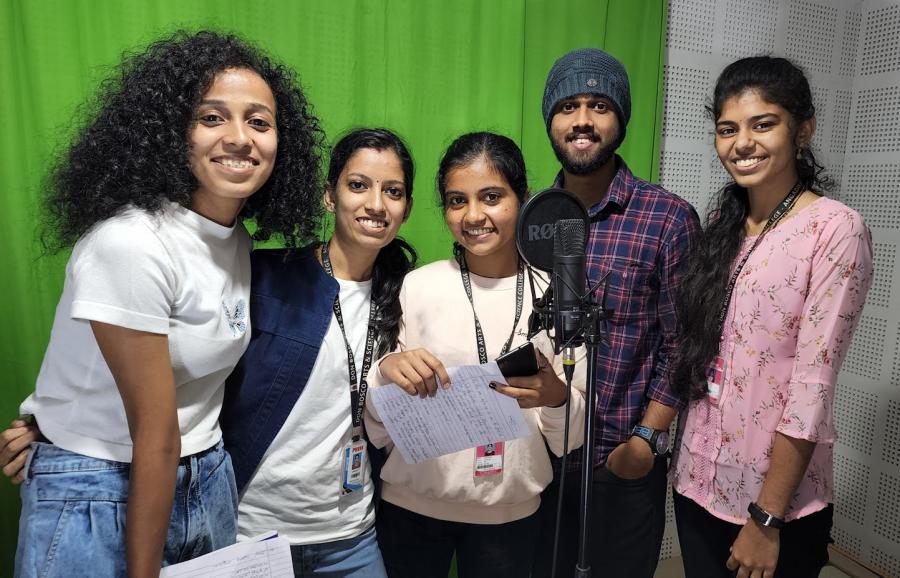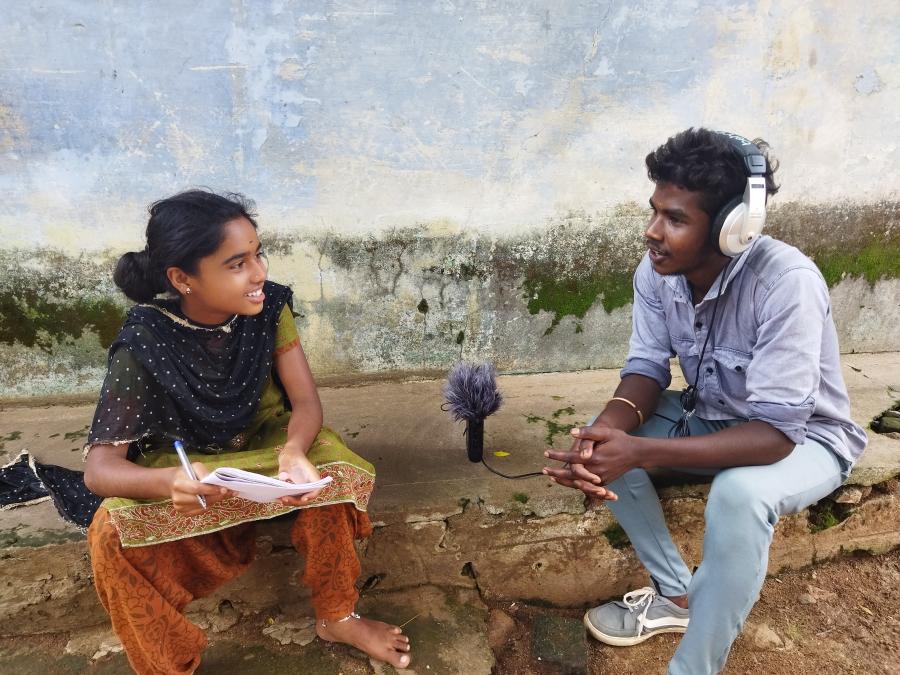Indigenous people all over the world have for centuries through the present seen their lands taken away from them, their humanhood robbed and their culture destroyed and deprecated. Being people bred in solitude and natural surroundings, with spontaneous and intuitive responses they have developed their family systems based on their own genius, innate skills and requirements. The child is an integral part of the family and the family a part of the group tradition. So the child is in effect a cornerstone of the social fabric and economic system of the group.
The birth of a child in most indigenous communities, particularly among some tribes in India, is welcomed with an invocation to the world to bless the child. The elements such as the earth, the sky and the wind are requested to confer on the child the qualities associated with them. The birds, animals and even the humble earthworm are called upon to bless the child with their personal attributes. Such a child is brought up in the traditions of his forefathers and made to understand the value systems of the ancestors by the group itself. Normally, therefore, the child, the family and the group have a blended personality usually characterized by a common focus on the immediacy of the surrounding environment.
Effects of the Development Process
Most countries have enunciated policies and strategies to develop their indigenous population. But even without these policy statements, the normal economic, technological and social processes of development have to a large extent adversely affected the lives of millions of indigenous people.
In central India, the forests, which once provided the playing fields for children, and the source of food and medicine, are no longer available to the indigenous peoples, as more and more forest areas go under government control as reserved forests. The ruthless exploitation of the forest wealth, indiscriminate mining activities and the building of huge projects have displaced large numbers of indigenous peoples from their homeland, shoving them into congested rehabilitation centers where the children suffer from malnutrition, skin diseases and influenza as they come into contact with previously unencountered ailments. Diseases such as syphilis and tuberculosis, once not very prevalent among the indigenous peoples, have had a particularly harsh effect on the children.
Groups who were once self-sufficient, with enough food, milk and medicines from their own sources, have gradually been reduced to a dependent and confused people. The dwindling land resources, change in cropping pattern and the unavailability of forest resources for food, fuel, fodder and medicine have had their effects on the children particularly. The impact of economic change for these tribes has been, according to Professor Haimendorf, an "enlarging of economic networks" and "interdependence" with the progressively expanding dominant population. The competition for scarce resources (particularly land) has resulted in many tribal peoples mortgaging their land to moneylenders, contractors and landlords, who surreptitiously manipulate the debt records holding children in bondage for their ancestors' debts. Such cases have greatly decreased since legislation banning bonded labor was passed, but it is difficult to detect and prove such cases due to the subtle informality of the arrangement.
Children in general are very vulnerable to development, but more so indigenous children, unused to outside contact. In particular, female children are still more vulnerable. Within indigenous populations, many studies have shown that there is a fair amount of equality among the sexes, particularly among children. But, when coming into contact with the dominant cultures, an indigenous female child has much more to overcome as she is faced with an unequal society where more than often a female child has a lower status than a male. The consequences of such contact is that she is automatically slotted for less education, less pay for work, less health and nutritional care and often reduced to a sexual object. She has also to work harder in the family as family value systems disintegrate and more and more young men become the semi-educated unemployed and stop helping with household and agricultural work. The subtle molding of children of indigenous peoples to appreciate the clothes, consumerism, religion, art and living styles of the dominant cultures, abandoning the richness of their own values and wisdom, is a sad example of what the world is losing along with its flora, fauna and a clean environment.
Strategies for Development
Not many studies have been done on the impact and effect of the development process on indigenous children. While all of the broad issues which affect indigenous people apply to women and children, specific issues like coping with the adverse effects of development on the domestic front and socio-psychological adjustments can be particularly hard to them. What happens to indigenous children during the first stages of contact with outsiders, when they are sucked into the vortex of an alien environment whose materialistic orientations will determine the future of indigenous people? Will these children assimilate so completely with the dominant culture that they lose their separate identity? Most governments seem to hope for this situation so that the "problem" will be solved automatically. It is hoped that the unimaginative school systems with rote learning, noncreative approach, and promotion of the culture and the value systems of the powerful groups will bring the indigenous children into the "mainstream of national life."
The education system of the dominant groups has, in the name of eradicating illiteracy, produced a considerable number of semi-educated indigenous youth who remain unemployed with an acquired bias against traditional occupations and manual labor. With the increasing pressure on their lands and dwindling land holdings, the indigenous peoples have been forced to change their cropping patterns from food crops to cash crops which have impoverished them further and adversely affected nutritional intake. Often the youth migrate to semi-urban agglomerations where they may have to live in degradation and frustration.
Fortunately, there does, however, seem to be an alternative to this unhealthy strategy. It has been demonstrated in India that children of indigenous people can be given the opportunity to develop in their own genius and in their unique cultural milieu with dignity and pride and contribute significantly to the national life, without necessarily having to adopt the attitudes of the majority.
The way in which the tribal youth of Arunachal Pradesh of India have developed is a classic example. The enlightened policy by the government to selectively protect the tribal people from not only economic but also cultural exploitation has resulted in both the male and female youth of Arunachal Pradesh presently participating in all the spheres of the state and private activities with minimum of disadvantages and complexes. With the government acting only as a and complexes. With the government acting only as a catalyst - providing education, health, infrastructure and economic facilities to the population, with very little external interference in the culture and social organization of the people - the Apa Tani youth have retained their confidence and self-respect. Government schools have enabled the Apa Tani children to avail themselves of a sound education, irrespective of their parents' capacity to pay.
The same, however, cannot be said about the tribal people of central India, who are much larger in number and more exposed to overall exploitation, due to their vulnerable geographical location. In these areas the indigenous peoples are extremely dependent on the government machinery for protection of their rights and for development. This has led to much slower progress in the development of independent attitudes among the children.
Similarly, the Nishis and the Miris have made considerable progress in the education of their youth. There are presently many university graduates among them and several boys and girls are enrolled outside Arunachal Pradesh for graduate studies. It is significant that as the members of the state legislature are largely from the "tribal" groups, aspirations of the people are usually reflected in state policies.
Unfortunately, the same cannot be said about the tribal people of central India, with some exceptions. The Gonds, Saoras, Bhils and Mundas, for example, are numerically much larger and have been more exposed to overall economic and cultural exploitation over centuries of contact with the dominant majorities. The vulnerable geographic position, which allows easy access and exposure, has resulted in gradual displacement of the tribal peoples from their lands. In these areas the indigenous peoples are extremely dependent on the government for the protection of their rights and for their overall development. This has led to much slower progress in the development and independence of attitudes among the children.
Government schools were established in Andhra Pradesh almost a decade earlier than in Arunachal Pradesh, yet relatively few Gonds or other tribal youth have become officers or professionals. The educational system, which is focused on the dominant culture and excludes issues of relevance to indigenous peoples, tends to produce frustration and dissatisfaction among the youth. Many of them drop out of school to look for employment.
The education of "tribal" children has caused concern to the government, which is presently discussing the components of the New Education Policy, which will have a specific and relevant focus on the educational curriculum of "tribal" children. It is hoped that the new focus will include the historical and cultural aspects of the indigenous peoples, promotion of tribal dialects, vocational education, emphasis on female education, ashram (boarding) schools for boys and girls and the introduction of basic information on technology to help in the understanding of the upgrading of their indigenous technology.
Government Policies
Women and children have always been accorded a relatively low priority in the development objectives and strategies of most countries. It took the United Nations declaration of decades for women and children to activate most governments to focus some attention to the issues. And still comparatively less money is allocated toward the development of women and children in practically all sectors of government. Accordingly, the effects are very marginal by the time they reach indigenous children. Due to the difficulties in communications, infrastructure facilities and political-bureaucratic factors there is always a considerable developmental gap between the more accessible and the remote regions. In most governmental programs, one finds a reluctance on the part of trained personnel to be posted in the areas where indigenous people live. In fact, most developing countries still lack adequately trainee personnel to implement programs for women and children. Paired with no political or economic imperative to provide basic facilities for women and children, pressures to bring large industrial, hydroelectric, mining or deforestation projects in these areas work to the detriment of the original inhabitants. "Development" seems to connote only that which is economically profitable. It is small wonder therefore that the development of women and children, particularly of the indigenous people, which is nonremunerative and not visible, is considered almost a soft option in the current concept of development.
There must be a global perspective and goal in the development of indigenous children and peoples, to create an environment where indigenous children can grow up with dignity, fair play and justice while receiving the health and educational facilities which engender creativity and self-development. The more happy and well-adjusted children of today will be the more confident and productive citizens of tomorrow. Ah, but how myopic is the world!
Article copyright Cultural Survival, Inc.



